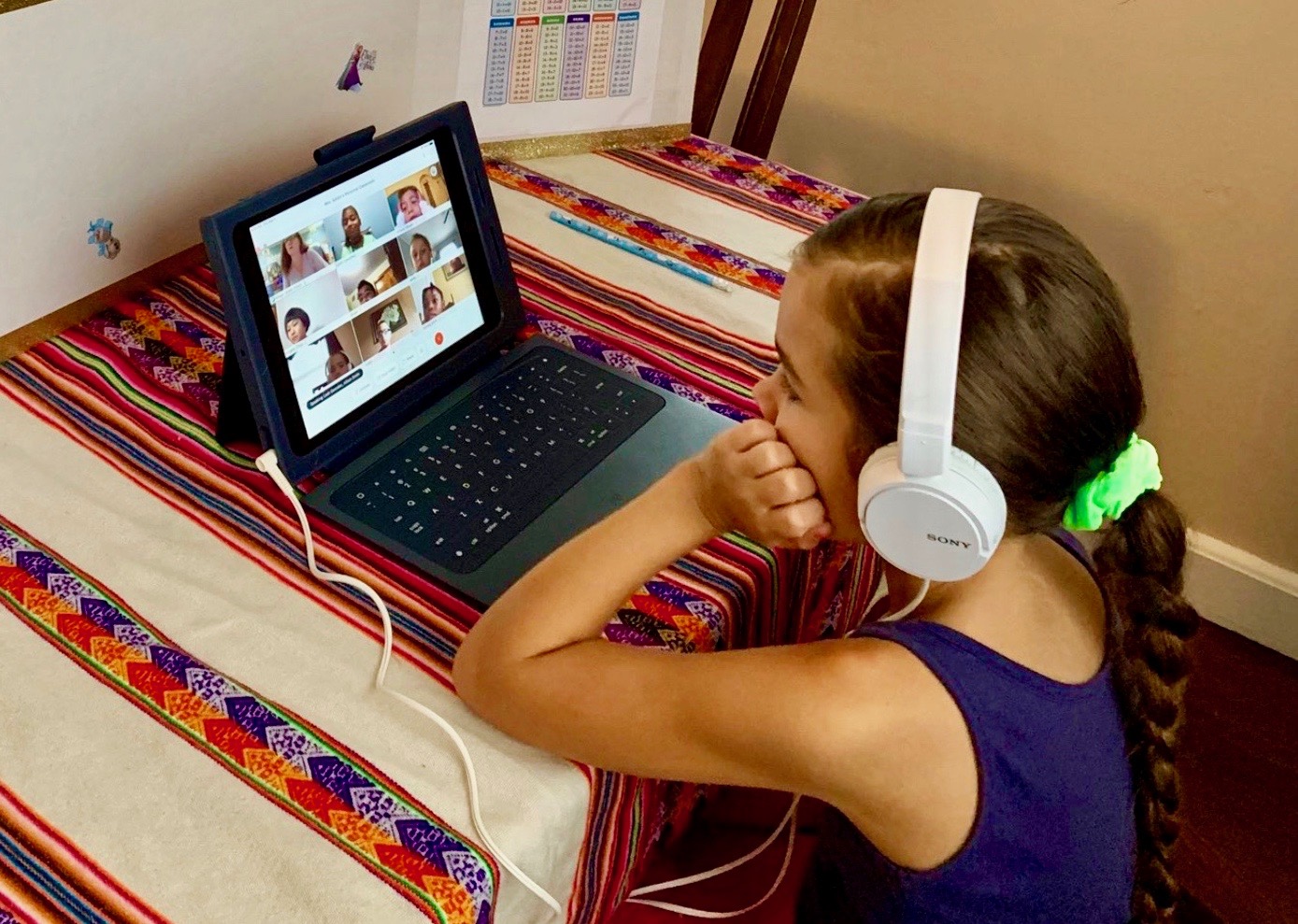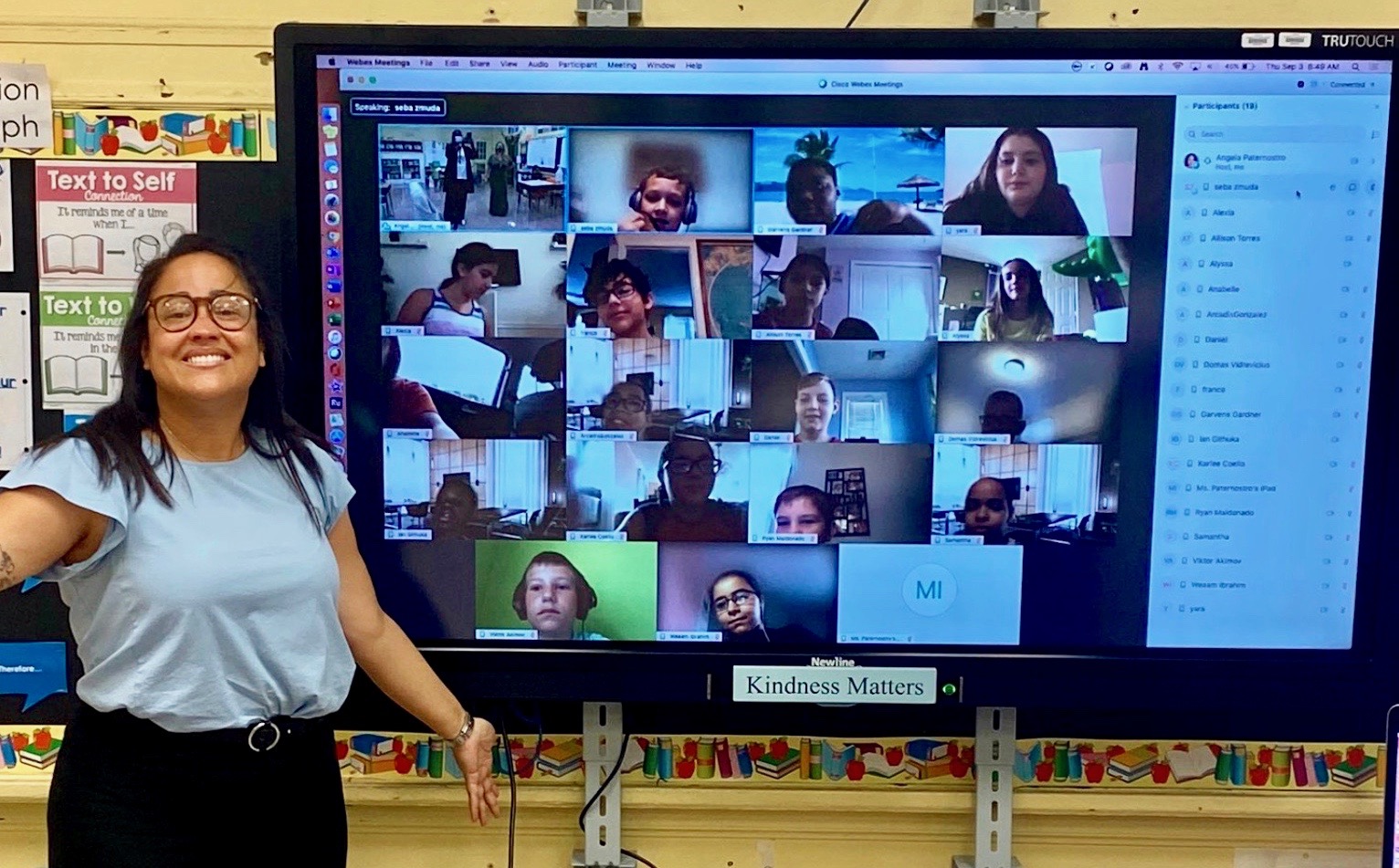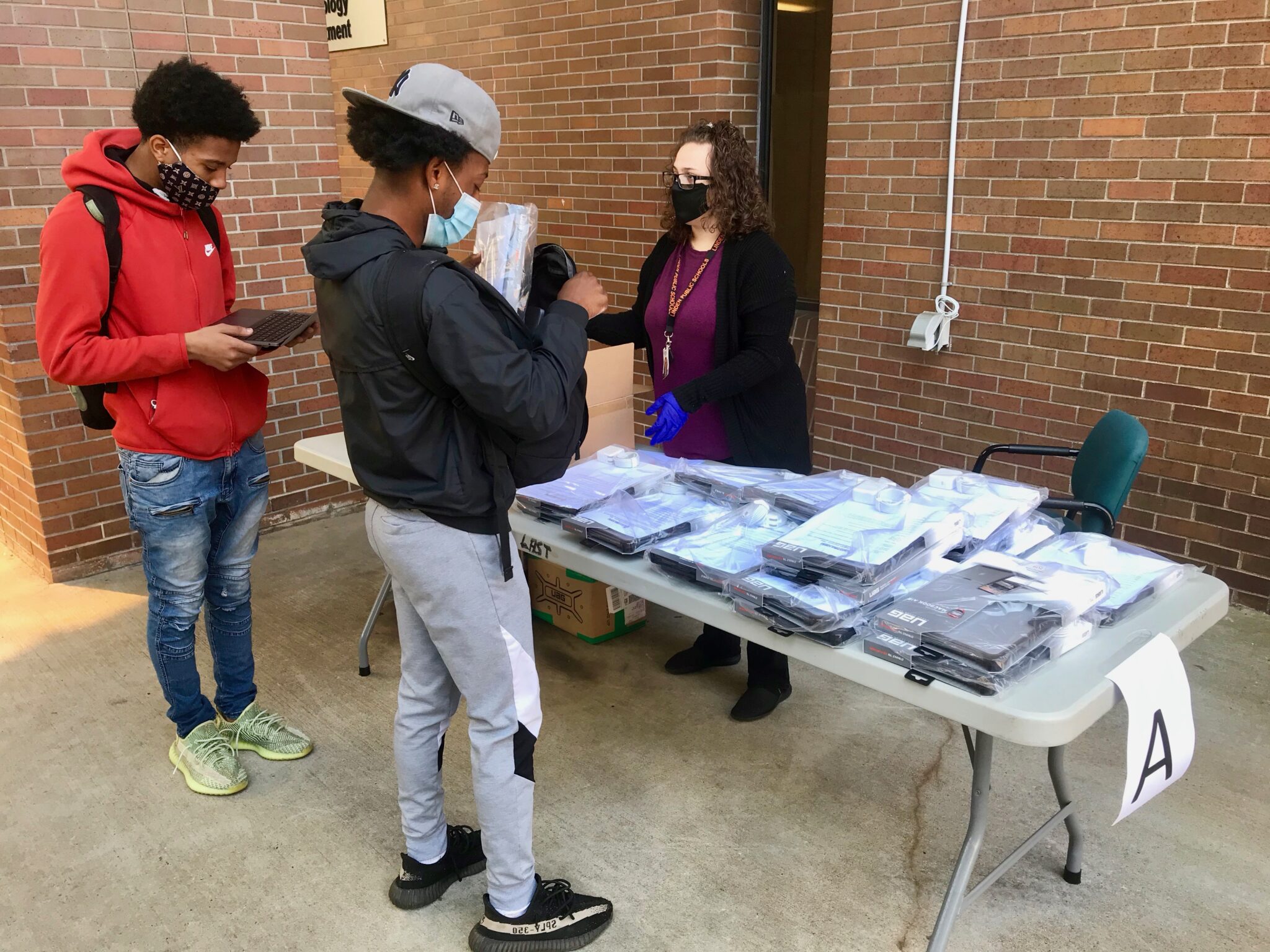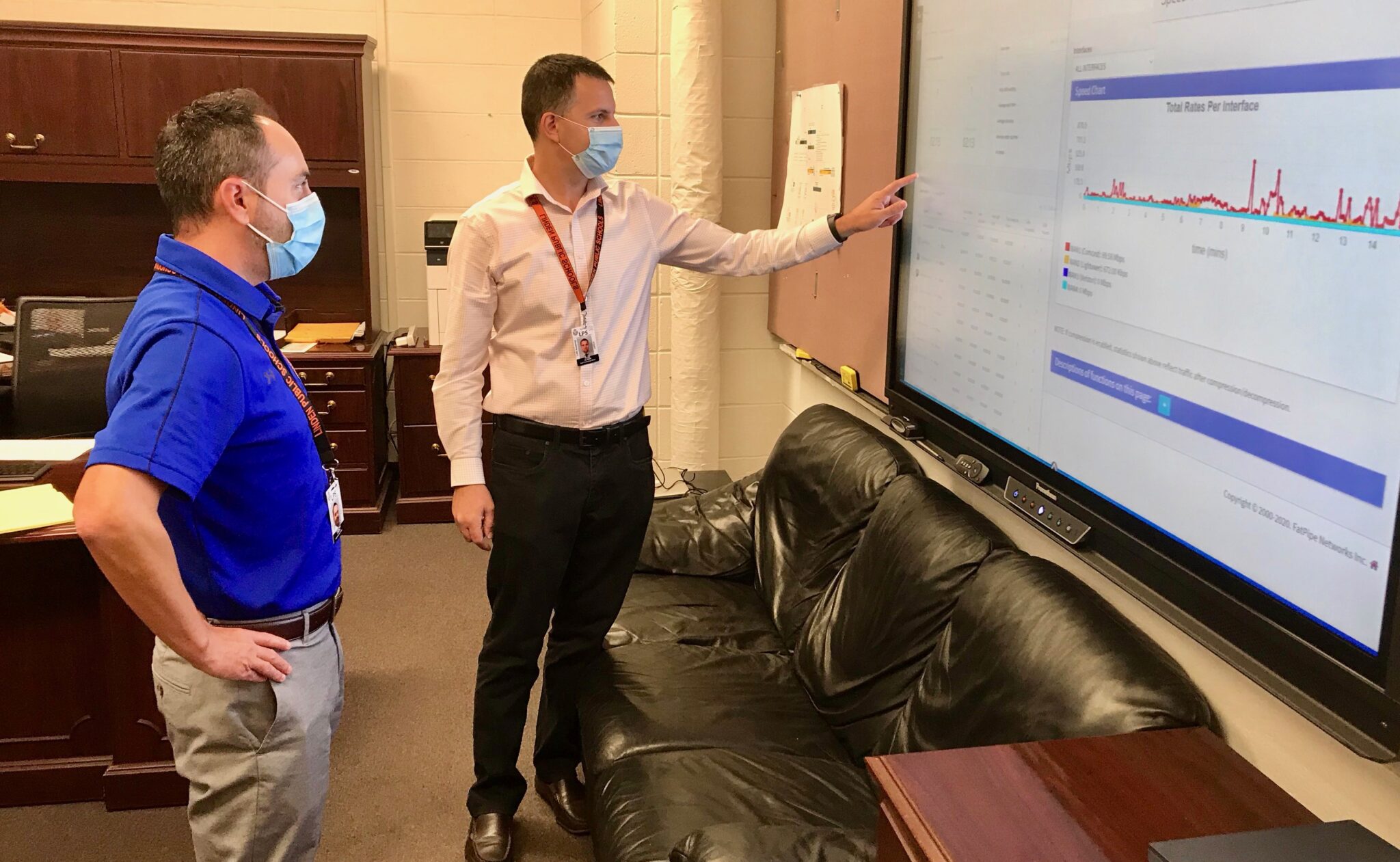
(above) All Linden elementary school and middle school students are issued iPads through the district’s One-to-One program, which provides a device to every child in the district. The program began in 2013 and put Linden a step ahead of many other districts when virtual learning began.
Technology Keeps Students & Teachers Connected
Submitted by Gary Miller
Since remote learning took hold in Linden Public Schools in March, no area has been put to the test more than the district’s technology. When students are at home, their ability to learn hinges greatly on their ability to seamlessly connect with their teachers, access their lessons, and get the virtual support they need to thrive.
At the hub of everything digital, has been the LPS Technology Department. This small but savvy group has gone to great lengths to keep the educational data flowing day after day.
With some students returning to elementary schools on October 13, the hurdles will only increase. But major upgrades being completed to the district’s computer infrastructure will allow students and staff to meet these challenges head on.
“I know that there are glitches and issues, which is unfortunate,” said Joseph Scaldino, the district’s supervisor of instructional technology. “We can’t take everything out of the equation, but for the most part, I feel like our kids are learning, they’re actively engaged. Does it replace the classroom? Probably not. But it’s a close second.”
Scaldino works closely with Chief Technology Officer Slawek Pajak to head the Technology Department. They have worked hard to make sure students have the updated equipment, personal devices, and internet access they need to learn in an unprecedented situation.
This year that means:
– Distributing more than 130 T-Mobile hot spots to families that do not have internet access at home. This allows the district to bridge the digital divide by giving underprivileged families unlimited internet access at home.
– Upgrading the district’s technology infrastructure to increase bandwidth by 10 times within the schools and three times to the internet. This upgrade will be completed in early October and allows for more users to be on the system at one time without delays or outages.
– Distributing new MacBook Air laptops to all Linden High Schools students and teachers.
– Distributing new iPad tablets to all kindergarten and Pre-K students.
– Manning a technology help desk and call center from 7:30 a.m. to 3:30 p.m. every school day.
“I feel that we’re doing really good work here,” Scaldino said. “I’m very proud of what we’ve accomplished in a short amount of time.”
Superintendent Dr. Marnie Hazelton was impressed before she even stepped into her new position in July, saying that Linden Public Schools have “the best technology department that I’ve seen across the country.”
“Our Technology Department has been doing an extraordinary job throughout this COVID crisis,” she said. “We literally could not have taken on the challenge of virtual learning without them. And as we enter the next phase of having students divided between in-person and virtual learning, we will once again be leaning on the Technology Department. I know they will do a great job for our staff and students.”
* * *
Linden is a One-to-One district, meaning that every student has an Apple device issued to them. Students in Pre-K through eighth grade each have an iPad tablet, and high school students each have a MacBook Air laptop. This unique program, which has been in place since 2013, came in handy when the COVID-19 pandemic hit.
“A lot of people were not as prepared for this as we were,” Scaldino said. “I don’t know of another school district in New Jersey that’s doing as many Apple devices. March 13 we were able to pull our kids out of school and start with our virtual platforms the very next week.”
But that didn’t mean that the Tech Department’s job was done – not by a long shot. They have three network engineers and seven full-time technicians and three substitutes to cover 13 buildings and 10,000 devices in the hands of 6,500 students, 700 teachers, and 500 support staff.
The district set up a tech help hotline (908-747-4001) for parents, students, and staff members to call if they were having any issues at home. It is run through Zendesk, a professional-level help desk setup that allows Pajak and Scaldino to track call volume.
Volume was especially heavy at the start of this school year as students adapted to new procedures after possibly not having used their device all summer. From the start of school through September 23, the help desk had received over 5,000 calls and 1,000 live chats, and logged a staggering 13,000 minutes of time when users were talking to technicians and aides.
“It has slowed down a lot,” Pajak said, “but the first few days we were getting 700 or 800 calls a day.”
With teachers returning to work in the schools, another major issue is bandwidth. With everyone logging at the same time, how would the network handle the heavy traffic?
Teachers were divided into two cohorts, so only half would be in school using the network at any time. But with students expected to begin returning to class, that number is going to increase greatly.
That is where the infrastructure upgrade comes in. The Tech Department is installing new core switches, two new wireless controllers, new firewalls, and changing from an in-line internet filter to protect children from inappropriate content to one that is cloud-based. Pajak is well-versed on all the technology aspects of the upgrades, but he summed it up for those who may not be as tech-savvy:
“This will make things a lot faster for all the schools coming back.”
He said that the district’s bandwidth was at about 50 percent capacity with half of the teachers working in the schools. After the upgrades, the system would be at just 30 percent capacity even with all teachers and students back in school.
“So we’ll have a lot of leeway for streaming video or teachers using two devices,” Pajak said. “We’ll have more than enough bandwidth to support synchronous learning.”
The upgrade was made possible through the district’s existing contract with Cisco Systems, which Pajak described as top-of-the-line equipment. The list price for everything is $1.2 million, but the district was able to get it done for just $112,000, because of discounts through Cisco and the federal E-Rate program, which assists schools and libraries in upgrading their technology. The upgrade was approved by the Linden Board of Education on September 24.
Another boost was the redeployment of classroom aides from around the district to help handle the workload at the Tech Department’s headquarters at Linden High School’s Academy building.
“They’ve been vital to our success over the last couple of weeks, because we’ve been inundated with calls for small issues,” Scaldino said. “Every September is crazy, no matter what. But this year, because all of our students are off-site, we haven’t had a chance to even upgrade any of their devices. So I think it made it a little bit more chaotic in the beginning of the year.”
* * *
Bridging the digital divide is an issue that schools around the country have struggled with. Many students have been left behind during virtual learning because of a lack of computer or internet access at home. The computer access wasn’t an issue for Linden because of the district’s long-running One-to-One initiative.
Internet access at home was a different story.
“This was hitting the kids last year who had no connectivity whatsoever,” Scaldino said. “We have students in district, unfortunately, who have no means to connect.”
That is why the T-Mobile hot spots are so important.
“This bridges that gap for students who have a device but they don’t have a way to connect with their teacher,” he said. “That’s been a major factor in helping these children. Those students who are getting lost are the students who don’t have connectivity to their teacher. I think that is a major thing that we’ve accomplished this year.”
The upgraded laptops for high school students were another major boost. Some students had been using devices that were seven or eight years old, Scaldino said. So the Tech Department set up days for students to visit the LHS gym or Academy dome for socially distant device pick-ups.
“Our kids don’t get enough credit, especially our older kids, the 11th and 12th graders,” Scaldino said. “They’re adults and they want to do the right thing. They’re social distanced, they’re coming in and getting their computer. Really, I’m very proud of our students.”
* * *
After some rough days to start the school year, Pajak and Scaldino are proud of what their department has done and excited about what comes next.
“In three weeks, I think we’ve accomplished a lot,” Scaldino said. “Kids are learning. If you walk through the buildings, you can see teachers teaching with students on the other end.
“I’m excited to get the kids back, though.”

(above) Angela Paternostro, a fifth-grade teacher at School No. 8 in Linden, in her classroom connecting with her students at home through Cisco Webex, the district’s secure platform for virtual learning.

(above) All Linden High School students recently had their MacBook Air laptops upgraded to brand new models under the Linden Public Schools One-to-One program, which provides a device to every child in the district. The program began in 2013 and put Linden a step ahead of many other districts when virtual learning began.

(above) Linden Public Schools Supervisor of Instructional Technology Joseph Scaldino, left, and Chief Technology Officer Slawek Pajak review data on network usage and call center volume. The LPS Technology Department is upgrading its network and distributing new devices and home hot spots to make sure the district continues to function well whether students are in school or at home.





